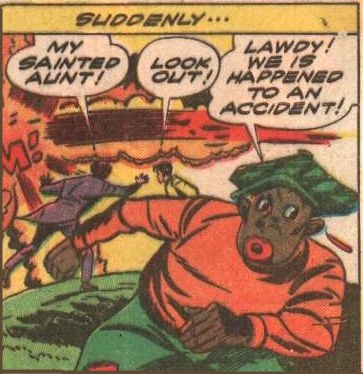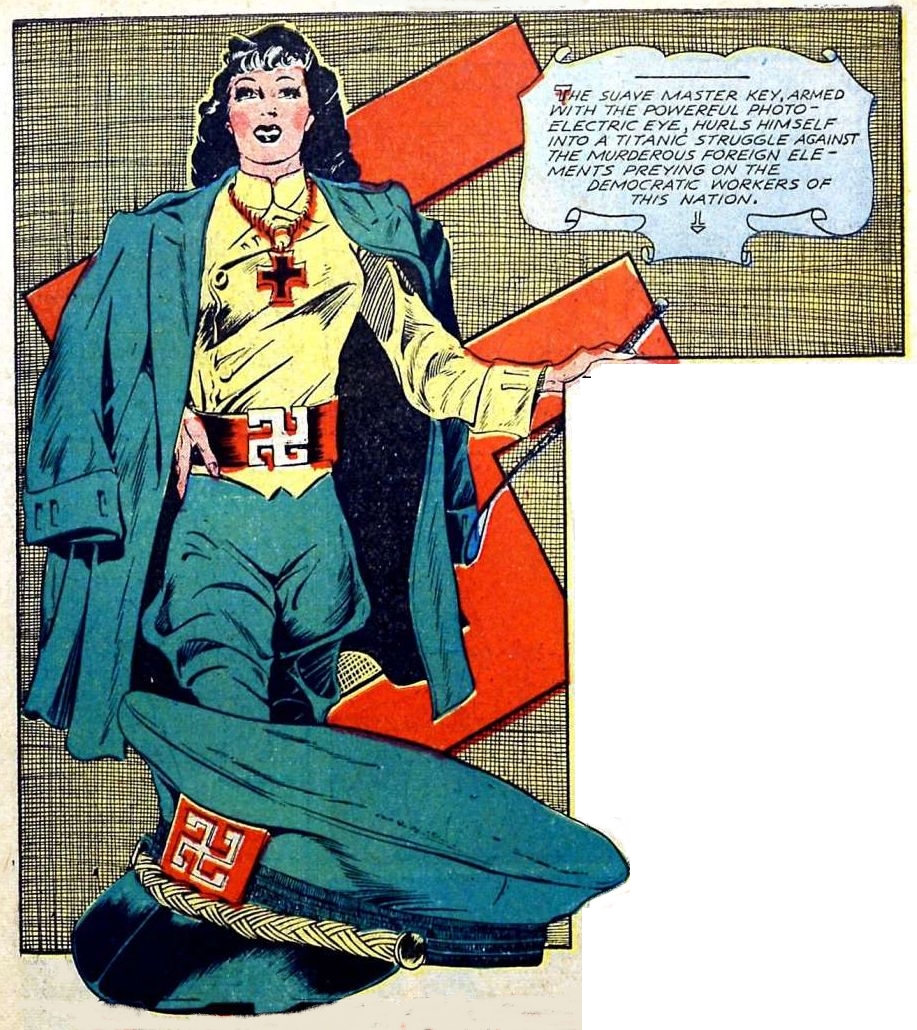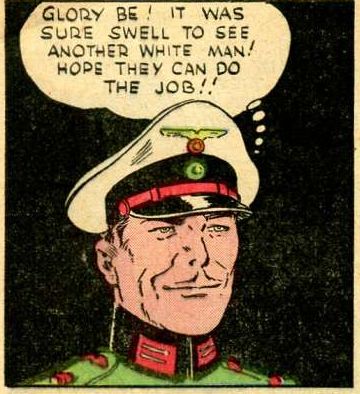Axis US?
Comic book heroes fought a war of genocide and racist extermination, all the while professing to uphold American ideals. And they rarely if ever fought for equality on the home front. The lofty rhetoric of flag-draped heroes was nothing but propaganda. So far, we have only looked at how comic books depicted non-American whites, as well as so-called Orientals — Chinese and Japanese. We have not mentioned Blacks, who of course had been suffering in America ever since the first slave ships arrived.
In "Immigrant Stereotypes: 1880-1900", author William Linneman describes how a stage type of Black man was evolved for comic effect. The Black man of the minstrel joke book tradition "became a shiftless fellow with unusual weaknesses for chicken coops, watermelons, big words which he only partially understood, crap games, and razors used primarily for social purposes. The burnt cork performers "made up" with large mouths to reveal rows of shining white teeth and exaggerated grins, and dressed in outlandish and gaudy costumes."
In wartime comic books, blacks were almost never seen either among civilians or in the military. But the few examples that can be found adhere strictly to the stereotype, both when it comes to character traits and outward appearance. For instance, the Young Allies, one of the many groups of child soldiers, counted a Black boy among its members. His name is Whitewash Jones, and he is a kid "who can make a harmonica talk and watermelons disappear".
A competing band of child soldiers were the Commando Cubs, described as "five fearless American boys who swing into battling action." They, too, had a Black member. His name was Pokey Jones, and he was definitely the least fearless of the Cubs. He has big lips, a wide mouth and dresses in gaudy clothes when not in uniform. But unlike Chop-Chop, he at least has one.
The name Pokey is derogatory, just like Whitewash. While Whitewash is a Hollywood term meaning a character's race is changed to white or just ignored, pokey means "slow", or even "jail". In Thrilling Comics #42, the Commando Cubs fly in a plane through turbulent air. One Cub says he is going to shoot the Arcturus, meaning taking his bearings by observing a star, which causes Pokey to reply: "While yoah at it (gulp)- - git the critter what am rockin' dis plane! Ah's gettin' airsick!"
Kid Patrol was still another band of youngsters. This one even had a girl member, as well as a Black boy by the name of Sunshine. Unlike the Commando Cubs and the Young Allies, the Kid Patrol did not take an active part in the war, but stayed at home battling criminals of every stripe. In their stories time seems to have frozen, preserving a nostalgic and innocent pre-war small-town America forever, much like a Norman Rockwell painting, except the racism is on full display. "Well, ah declare," Sunshine says. He is illiterate and cannot tell time. He is also superstitious and dresses in worn-out boots, red pants with green polka dots, a red shirt, yellow gloves and socks, and an old yellow top hat. In other words, he is a clown, included among the kids to provide comic relief.
As we have seen earlier, women in occupied Europe played one of two possible roles: Traitor or freedom fighter. Except for the occasional grandmother, they were all pretty and young, with their shapely legs encased in nylon stockings — an American product, by the way, invented in 1939, which couldn't be bought for money in occupied Europe during the war years. Women also served as victims of German and Japanese atrocities, especially blonde ones, likewise in nylon stockings.
Another female stereotype was the sexy femme fatale. The dragon ladies of the Orient belonged to this category. But dangerous women were not always Asian. Airboy had several clashes with a German called Lisellotte von Schellendorf. The "von" reveals she was of aristocratic stock, but she was no mere arrogant Prussian. From childhood she had been trained to be a masterful pilot, as well as a fanatic Nazi. As a grown and sexy woman she fought the Allies in the air and on the ground under the name of Valkyrie and even created her own squadron of girl pilots — the Air Maidens. Perhaps Airboy's most dangerous adversary, it seems only fitting that she eventually changed sides and fought for the Allies instead. The wild femme fatale had been partially domesticated.
One more example of dangerous women was Baroness Nohart, a German villain, who appeared in Scoop Comics #3. The baroness seemed to be evil incarnate, and her sex appeal was even greater than that of Valkyrie. She was totally devoted to the Nazi cause, however, and appeared to have little use for men. At one point she exclaims: "Bah, you blundering fools, our fuehrer should have all women agents. Things would be accomplished." One remarkable thing, however, is that, unlike their male counterparts, all these dangerous women seemed to have complete mastery of English.
On the Allied side, girls took part in the war as well. The Girl Commandoes, last seen at Haugesund in Norway, is an interesting example. This group proved that girls could fight and win, and in that respect the feature was ahead of its time. But the stories about Pat Parker and her friends also shows something else. Sure, girls could fight as the boys, but their main mission was also the same as theirs — American propaganda.
Black stereotypes dates back to the first minstrel shows. But where does the concept that people from Asia are yellow come from? It's obviously wrong, as no people outside the Simpson's universe have skin that color. Still, Asians have been classified as "a yellow race", and Michael Keevak provides an answer to this mystery in his book, "Becoming Yellow: A Short History of Racial Thinking."
According to Michael Keevak, "before the end of the eighteenth century there was no systematic desire to classify people according to what we now call race. Western thinking had long differentiated between the peoples of the known world in a variety of ways, including often vague notions about skin tone. But markers such as religion, language, clothing, and social customs were seen as far more important and meaningful than the relative lightness or darkness of the inhabitant."
The first Europeans to chronicle encounters with East Asians almost always described them as "white", and never as "yellow". Both Chinese and Japanese were much admired and considered to have the same color of skin as Europeans. One of the first to depart from his was Carl von Linné in the mid-1700s. Linné (or Linnaeus) had already classified the flora and fauna of the world, and now he felt a need to classify the different peoples as well. To him, a Swede who never traveled to Asia, Homo asiaticus had skin the color of sickly yellow. By this time Europeans were no longer in awe of the Chinese, and felt an urgent need to differentiate between their superior, Christian culture and the one in the stagnant, despotic, and superstitious East. So not just yellow, but sickly yellow.
It took the untiring work of many more racist scientists before the notion that Asians were yellow was universally adopted, but by the time Kaiser Wilhelm II launched his warning about the Yellow Peril in the late 1800s, everybody knew what color of skin people in East Asia had.
Only people of European descent could be white, as this color — or as it sometimes was presented, lack of color — meant civilization, science, and moral superiority, qualities lacking in the rest of the world. This is why, when Japan learned from the West and became a power to be reckoned with both financially and militarily, the country still could not join the world powers as an equal member. As a commentator in the beginning of the 1900s remarked, the Japanese were "lighter than yellow, but not enough."
In 1910, Franklin Giddings, an American professor, created what he insisted was a "scientific" scale ranking the different racial groups in the US. At the very top he put white Anglo-Saxons like himself, born of non-immigrant parents. Next came Anglo-Saxons born in America, but of immigrant parents, followed by other whites, foreign-born, but English speaking. In all, there are 10 steps to Giddings' ladder, and the seven first are different categories of whites. Only in eighth place do we find the first non-white group, classified as "Asian yellow". Unsurprisingly, the two lowest steps on the ladder consist of "Civilized dark" and "Uncivilized".
Giddings' scale explains a scene in a wartime comic book that at first sight seems totally weird. Tip Top Comics #74 from 1942 tells the story of an American agent, who goes by the name of the Mirror Man. In this particular story he travels through German-occupied Norway in search of another American agent who is in possession of important papers eagerly awaited in Washington. After hooking up with the other agent, Mirror Man leaves with the papers, while the unnamed agent remains behind, thinking to himself: "Glory be! It was sure swell to see another white man!" And this in Norway, the whitest of white countries (at least at that time). But if we check Professor Giddings' scale, we will find Norwegians in the fourth group from the top: "Northwestern European". In other words, although a few steps higher on the scale, Norwegians, like Japanese, were not quiet white enough.
There is only a short step from Giddings' scale to another "science" in vogue at the time: Eugenics, which has been defined as "practices that aim to improve the genetic quality of a human population". This can be done on one hand by encouraging couples with "good genes" to have offspring, and on the other to prevent undesirables from having any. As Edwin Black in his "War Against the Weak" has pointed out, eugenics quickly became a pseudoscience, and the talk about improvement of the genetic pool nothing but scientific racism. In practice, the message was that only people at the top of Giddings' scale had the right to live, the rest be damned.
Britain was the first country to develop eugenics, and it soon became a respected science all over Europe. But until the Nazis took power in Germany, it was the US that most wholeheartedly embraced eugenics. Among other things, it served as a "scientific" basis of restricting immigration, esecially for "inferior races". The total number of coerced sterilizations performed in US is unknown, but the practice continued until recent times, and the vast majority of people denied having children were Black, Native American, Hispanic, and Asian. As late as 1973, two Black girls in Alabama, aged fourteen and twelve, were sterilized without their knowledge.
During the 1920s the second Ku Klux Klan became a mass movement in the US with at least four million paying and uniformed members. In the 1930s many American states adopted eugenics as official state policy, foremost among these was California, where several thousand unfortunates were sterilized without their consent or even their knowledge. Apparently California developed eugenics to such a level that the state later became the model for Germany's own effort, a fact the Nazis proudly pointed out. And they prized America's race laws in general, which served as a blueprint for Germany's own legal practices.
This dark history causes us to ask if the US might just as well have fought on the Axis side during WWII. The freedom the country ostentatiously fought for was the freedom of the few, the white elites — the man on top of Giddings' ladder.
But what about the superheroes? Despite being used by US propaganda, they were at least the good guys and on the right side of history? Fighting for democracy and crushing totalitarianism? Maybe not so much.
Nazism and superheroes can trace their heritage back to a common root: the German philosopher Friedrich Nietzsche. In his Thus spoke Zarathustra, Nietzsche launches the concept of the übermensch, a man who rises above and replaces the degenerate man of egalitarian modernity. Even though Nietzsche probably had something else in mind, the Nazis used the term to describe the superior Aryan and the German master race in such a way that the ones not übermenschen became naturally untermenchen, inferior people, who could be treated as such, dominated, enslaved, and killed with impunity.
Superman is a literal translation of übermensch. Coming from a planet out in space, he is of a different race altogether. The only one of his kind, and with his fantastic powers he stands head and shoulders above ordinary people. In a way, he is the whitest of the white (except Giddings would of course disagree, as Superman is as foreign-born as can be. Actually, he would fit the category immediately above Norwegian from Northwest Europe: "Foreign-born, English-speaking").
But Superman fights for good, you might protest. Except, in WWII he supported racist and genocidal US propaganda. And he did precious little to advance equality and race relations within the US.
Through all of history people of different cultures have had champions fighting for them. But past egalitarian societies as different as Norse Vikings and Native American tribes elected their champion, their king, or their war chief, which means that the hero represented and answered to the people. He was never a vigilante, or self-appointed freelancer culpable to nobody. In other words, he was Nietzsche's detested man of equality.
The übermensch or the Strong Man is central to Nazi thought — the leader who drains the swamp, cuts through the babble of everyday politics, and makes the trains run on time. This kind of rhetoric does not belong in a democratic nation. A true democarcy would elect new leaders to tackle corruption, clean up politics, and make the trains run on time without the aid of a strutting dictator.
All heroes in comic books are essentially the same, super or not. Few of them really represent anything but themselves, and most of them fight for reasons that are strictly personal: revenge for family members killed by Nazis, or just a vendetta with someone who happens to be a German. Vigilantism is regarded as a crime by all democracies. Nobody is above the law, or has the right to take the law in his own hands. And this way it has to be, if democracy is to survive.
As we will remember, Blackhawk changes the color of his uniform to make it less like the enemy's. Other heroes draped themselves in the American flag, which is a way of saying "my country, right or wrong"; a mindset that belongs in a dictatorship. And it is almost too easy to picture, let us say, Blackhawk with a swastika on his chest, or the Shield with a German flag. The heroes are all violent übermenschen. What sets them apart from Captain Nazi and all the other bad guys is, their defenders say, moral high ground. They fight for a good cause, it is claimed. From what we have seen, this is only partially true at best. The ground might not be as high as you think, when you are employed by the propaganda office in a thoroughly racist country.
One last point. The heroes always win their battles; they kill German soldiers in occupied countries, even ending the war in 1940, like Thor did. In other words, US heroes are conflict solvers. When they are done, the conflict is ended once and for all. But the question is how they do it. How do heroes win? With violence, of course. That's why American heroes are "two fisted". Is that a good strategy in real life? Do your underage readers learn a valuable lesson to remember for the rest of their lives? Probably not.
War and racism are closely related. In order to finally win peace, both must be defeated. And violence is not the way to go, as it only begets more of the same.
All examples in this article come from Comic Book Plus a site for public domain comics. Try it, it's free!








